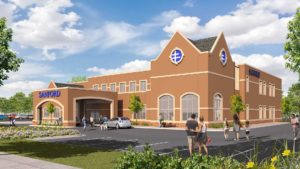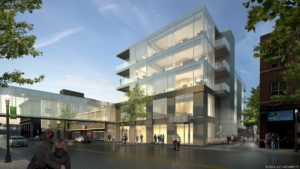In November 1930 a cornerstone was placed in what would become known as the Black Building on Broadway in downtown Fargo.
Businessman George Black financed the project with proceeds from the sale of his original Fargo store, which opened in 1912 at 112 Broadway, to Sears, Roebuck.
A store with no name
The sale occurred in the wake of stock market crash of 1929. As part of the deal, Black inadvertently sold the rights to the Black name to Sears; so for a time his new downtown business was known simply as the “The Store Without A Name.”
A remnant of that period—a price tag bearing the words “The Store Without A Name”—lives on as an artifact adorning a recently remodeled office of the eight-story icon.
The remodeling was part of an ongoing overhaul of the Black Building that started in earnest last fall and the antique price tag was one of several historical gems uncovered by the work, according to Adrienne Olson, communication director for Kilbourne Group, a development company that bought the Black Building about three years ago and is now remodeling the art deco landmark.
“We found it (the price tag) in one of his old offices here,” Olson said while giving a tour of the building that George Black built.
The reconditioning is happening in stages. The first phase now underway involves improvements to the outside of the building and renovation of floors two through five.
In many cases, office space is being left unfinished in order to allow potential clients a say in how the areas might be configured, said Deb Wendel Daub, project manager with Kilbourne Group.
When it comes to the big picture, the Black Building project includes the installation of new mechanical and electrical systems, windows, and fire sprinklers, Wendel Daub said.
Surprise underfoot
Wendel Daub and Olson say one of the surprises in renovating the building was the discovery that terrazzo flooring had been used throughout by the original builders, though in many cases it was covered by other flooring materials over the years.
Daub said Phase 2 of the renovation will include renovation of floors six through eight; with work on Phase 3—the lower level, main level and mezzanine—to follow.
Overall, the improvements are expected to cost about $9.2 million, excluding the cost of acquisition.
“The building has always been office space on the upper floors and retail on the first three levels, it will continue being that,” Olson said.
While some historical items discovered during renovation have been given to North Dakota State University for archiving, some things like the price tag are finding a second life as visual treats, including a wallpaper design that recalls the original hand-drawn blueprints for the building, which were also discovered during the rehab work.
In addition, reproductions of vintage newspaper articles have been framed as wall art.
Olson said when The Forum printed a Special Edition to welcome the Black Building to Fargo, it ran a picture of the lobby with a caption stating that more than 4,000 people daily walked through the building’s doors.
“If that could happen again, we’d be pretty happy,” Olson said.



